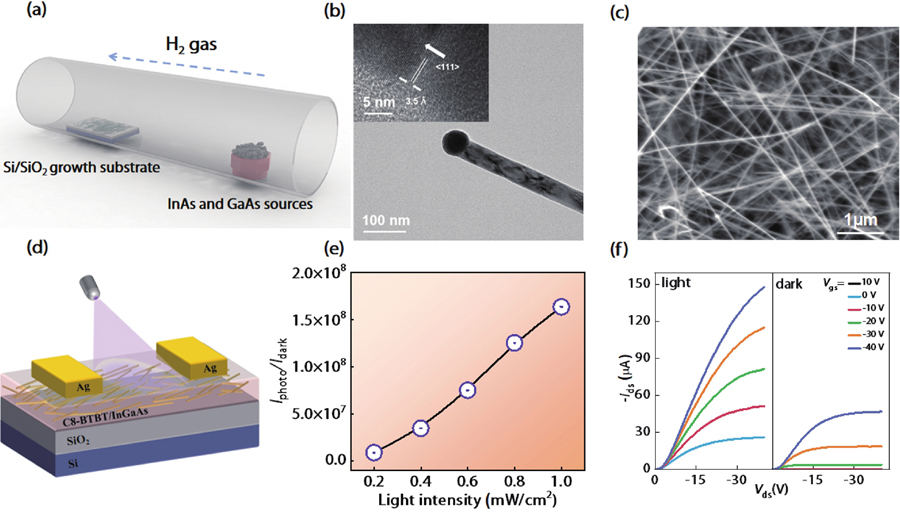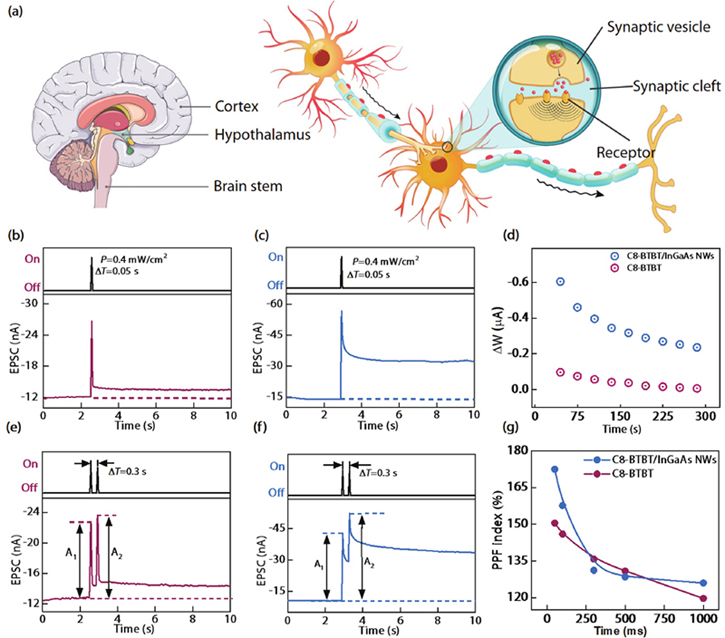Yiling Nie, Pengshan Xie, Xu Chen, Chenxing Jin, Wanrong Liu, Xiaofang Shi, Yunchao Xu, Yongyi Peng, Johnny C. Ho, Jia Sun, Junliang Yang. Hybrid C8-BTBT/InGaAs nanowire heterojunction for artificial photosynaptic transistors[J]. Journal of Semiconductors, 2022, 43(11): 112201
Search by keywords or author
- Journal of Semiconductors
- Vol. 43, Issue 11, 112201 (2022)

Fig. 1. (Color online) (a) Schematic illustration of the CVD setup for the NWs synthesis. (b) SEM image and (c) HRTEM image of the InGaAs NWs. (d) Device schematic of the C8-BTBT/InGaAs NWs phototransistors. (e)Ilight/Idark curve from the devices under light with different intensities. (f) Output characteristics in dark and under light (0.4 mW/cm2).

Fig. 2. (Color online) (a) Schematic illustration on the workings of brain connections and biological synapses. (b, c) EPSC stimulated by a light pulse for the phototransistors from pure C8-BTBT and C8-BTBT/InGaAs NWs transistors, respectively. (d) ΔW as a function of time collected from EPSC. (e, f) PPF measured from the phototransistors with pure C8-BTBT and C8-BTBT/InGaAs NWs transistors, respectively. (g) PPF index decay and fitting curves.
Fig. 3. (Color online) (a) Light intensity dependence of the EPSC with different light pulse stimulation. (b) Light pulse width dependence of the EPSC with different width stimulation. (c) The EPSC of 10 consistent light pulses measured from the different light intensity. (d) EPSC change extracted from (c). (e) Photonic potentiation and electric depression by 30 times of light pulses and negative electric pulses. (f) Stability testing of photoresponse of C8-BTBT/InGaAs NWs phototransistors.
Fig. 4. (Color online) Schematic illustrations of (a) the existence of electrons in the device after light illumination and (b) the recombination process of electrons and holes with voltage applied to the gate. (c) The complete association learning process. After training, CS can trigger UR (canine saliva secretion, unconditional response).
Fig. 5. (Color online) (a) LTP/LTD characteristics of the C8-BTBT transistors. (b) LTP/LTD characteristics of the C8-BTBT/InGaAs NWs transistors. (c) Simulated neural network accuracy for MNIST handwritten digit classification for the C8-BTBT transistors (red) and the C8-BTBT/InGaAs NWs transistors (black). (d) Schematic of SLP HW-NN. (e) Corresponding hardware implementation composed of PST crossbar array. (f) Change of the recognition rate with epochs of training.

Set citation alerts for the article
Please enter your email address



